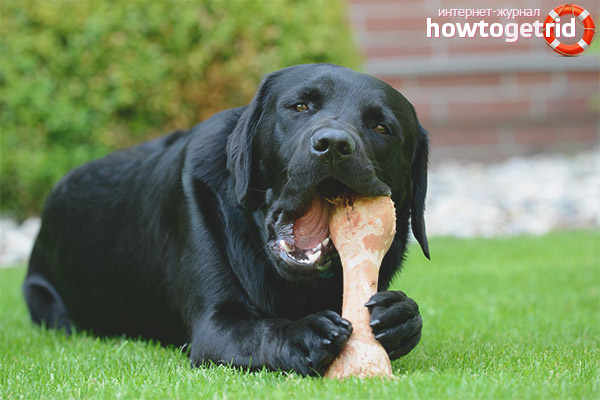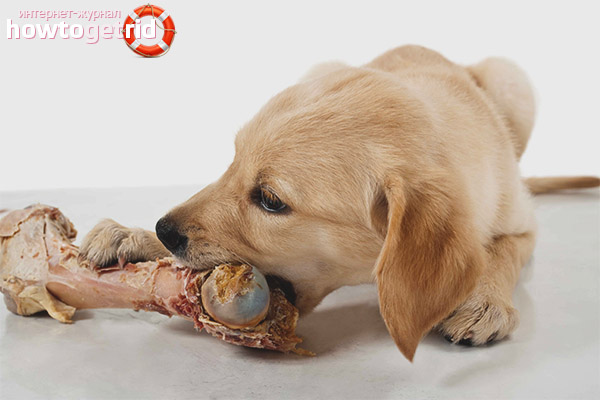The content of the article
Many people perceive feeding bones to dogs as something unacceptable. This is not surprising, because there is an opinion that it is impossible to give a pet bones. However, any dog that is exclusively on a natural menu should also have solid foods in its diet. For this reason, periodically, the pet should be given bones, however, this must be done wisely.
What bones can harm a dog?
The right diet is of great importance in the life of the dog. It is very important to understand that improper feeding can easily lead to health problems in the pet. Bones in this regard are a very dangerous product. Their fragments may not be removed from the stomach and remain there for more than one year. In some cases, even one harmless bone can be dangerous. For this reason, you need to know which bones should be given to the animal and which should not. We have identified a list of bones that are strictly forbidden to give the pet:
- Tubular bones of chicken. It is important to consider that it is forbidden to give an animal not only the bones of purchased hens, but also domestic ones. There are tubular bones in hens in the hips and wings.
- Turkey bones. This bird itself is quite large, moreover, it is allowed to slaughter traditionally in adulthood, at about 2-3 years. During this period, the bones of the animal already become quite strong.
- Goose bones. The bones of this animal are considered one of the most dangerous for dogs. Only duck bones can do more harm than them. The fact is that geese are usually slaughtered at the age of a year or two. By this age, the bones are already fully formed in birds, which makes them very strong. The broken edges of such bones are very sharp and can easily damage the internal organs of the animal.
- Rabbit Rabbit bones can also be a serious hazard. They are small and very sharp on broken edges. The most dangerous are the bones from the hind legs, spine and ribs. If you want to please your pet with delicious rabbit meat, it is better to choose meat or stew with cartilage for this purpose.
Many dog lovers cook porridge with bones for their pets. In this case, any bones can be used, however, after preparing the broth it must be carefully filtered and any, even the smallest particles of bones should be eliminated. Cartilages can be left in the porridge, they are useful for the body of the animal.
What stereotypes should not be believed?
The fact that dogs love bones, and cats - exclusively milk and fish products, we are told from early childhood. However, such stories are nothing more than a stereotype. Due to the fault of such stereotypes, most adult dog breeders can not even think that the bones can somehow harm their pet and, moreover, they can even kill them. It is necessary to understand that many stories are just myths that have nothing to do with reality, and such myths need to be debunked:
- A common stereotype is the myth that it is important that the pet has solid food in his diet daily, as occurs in wild animals. It does not have to be bones, you can use solid vegetables and fruits. Wild animals have a shorter life span; as a rule, they live no longer than eight years. This happens due to the fact that they lose their teeth quite early, as a result of which they can no longer eat normally. If you feed your pet with food, then you should not even think about introducing solid food into the diet, this is completely unnecessary.
- Another common stereotype is that the animal needs to grind its teeth, so dogs need bones. It is important to understand in this case that the teeth in dogs do not grow throughout life, but always remain the same size, and they do not become dull from food, so animals do not need to grind them. But the pet can easily damage tooth enamel about the bone or even break fangs, causing additional difficulties for itself in the future.
- The animal needs bones to brush its teeth. In this case, it should begin with the fact that only cartilage, and well boiled ones, can help with this procedure. For this reason, many dog lovers introduce raw pork bones, legs and ears to the menu of their pet. However, do not forget that from such food the animal can become infected with false rabies or other viruses that are absolutely not dangerous for humans, but for the dog it turns out to be fatal. Digestion of cartilage can help in this case, since high temperature destroys all bacterial cells. Such an additive in the diet of the animal will be very useful.
- Bones should be given to dogs at a time when their teeth are being cut. This stereotype is also very common. Perhaps, in earlier times, bones were indeed used to eliminate itching in an animal, but of course, they did not use tubular bones, but moslaks. Today, this is not necessary, because in any pet store you can find a huge number of various chewing goodies, which last a very long time. At the same time, they perfectly relieve the puppy from itching. Moslaks at such an early age also cannot be completely safe, since there is a risk of dislocation of the jaw or damage to the bite.
Many people know that the gastric juice in dogs has a high acidity, so that in just a couple of hours the bones become softer. However, it is important to understand that in this case the bones become a single viscous mass, which also does not bring anything good and can do much harm. Sharp bones within two hours can easily damage the stomach.
What troubles can a dog have after feeding bones?
If for some reason you still decide to feed your pet with bones, for example, based on the earlier experience of your relatives, you should prepare in advance for the possible consequences that the animal can overtake:
- Various pharyngeal injuries. Swallowing sharp bones is very dangerous. A small splinter can not only scratch the inner shell, but also pierce it. Since there are a large number of blood vessels in the pharynx, internal bleeding may begin in the animal. Also, the pet can pierce the trachea, which is also very dangerous.
- Asphyxia. Often bones get stuck in dogs between chewing teeth. The animal cannot independently pull them out and begins to gradually choke on its own saliva. If he is not helped in time, the pet may die from suffocation.
- Dehydration A large bone stuck in the stomach can lead to such consequences. Since it does not come out in the traditional way, the stomach begins to respond, throwing out vomit. However, in this way, the bone also cannot come out, as a result of which the animal vomits until complete dehydration occurs. In this case, saving a pet is possible only with the help of surgical intervention.
- Excessive accumulation of bones in the stomach. Most stray dogs suffer from this disease. As a rule, due to malnutrition in such animals, metabolism is disturbed. As a result of such violations, a noticeable decrease in the acidity of the gastric juice occurs. The eaten bones simply do not soften and do not go outside, but remain in the stomach, clogging it. An animal may die from intestinal and gastric obstruction or internal bleeding.Help in this case is also possible only with the help of surgical intervention.
- Perforation of the small intestine. A similar ailment can occur when an acute splinter passes through the esophagus and stomach, and then damages the small intestine. As a result, severe bleeding can begin, and then tissue death.
- Obstruction of the colon. Poorly digested bones can accumulate in the large intestine, clogging it and stopping the emptying process. As a result, the animal experiences discomfort and pain in the process of bowel release.
It is important to understand that bone is a mineral structure. The intestines of the animal are not able to remove calcium or other useful substances from the bone, so eating bones is absolutely useless for the pet.
Video: which bones can and should not be given to a dog











Submit